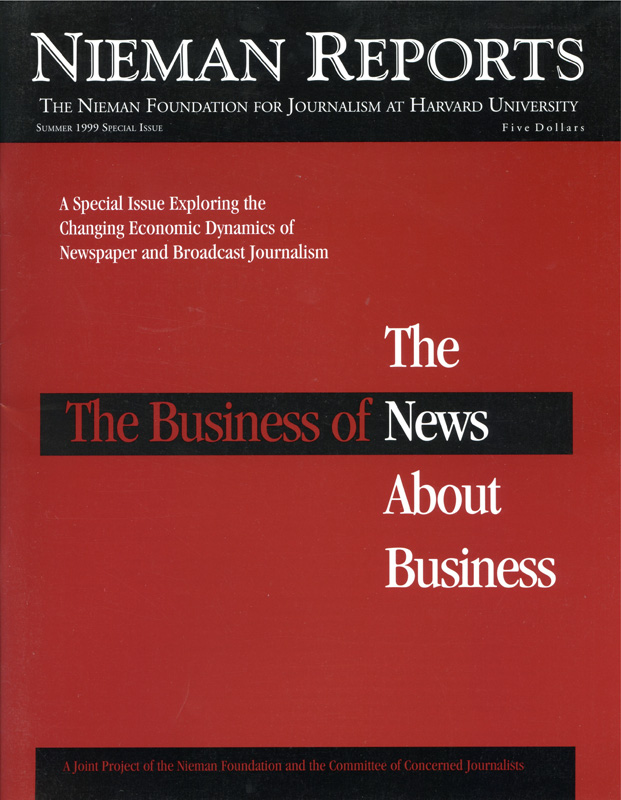Once upon a time the editor of a daily newspaper edited.
There’s little risk of that happening now. The top newsroom manager probably has a title like vice president and executive editor, spends most of the time in meetings with other vice presidents and the publisher, and reads news stories at the breakfast table just like any other vice president—or subscriber. The executive editor is increasingly an executive, seldom an editor.
This change confirms the transformation of the newspaper profession into the newspaper business. As recently as the 1970’s, an editor was the content boss, sleeves rolled up and wielding a pencil on a page proof at deadline. In some newspaper corporations, the editor didn’t even report to a publisher but was coequal to the top local business executive. If the editor reported to a publisher, the two likely had a symbiotic relationship in which the editor counted on the publisher to manage marketing issues, and the publisher relied on the editor to determine what news was suited to the community. Many editors became publishers.
In the 1990’s, an editor customarily is a member of the company operating committee—a senior member, perhaps even an executive vice president, but only one in a panel of peers, all of whom have more in common with each other than with the editor. The editor, like the others on the operating committee, is preoccupied with consultant reports and focus groups and the search for the latest theory or device to recapture lapsed customers or, failing that, the least injurious way to trim costs and maintain margin. Depending on the size of the community and the newspaper, the operating committee may have a dozen or more members. The editor’s influence upon the others may be less the consequence of rank than of relationships—with the publisher, with the vice president for advertising, with the general counsel, with the director of marketing, with the transportation director, with the human resources vice president. Some editors may still dominate corporate conversations about what constitutes news and how to deploy newsgatherers, but most no longer make such determinations singly or without elaborately justifying the effect on the bottom line.
Gone are the days when cantankerous editors in a media corporation asserted themselves at the annual editors’ meeting by giving the dickens to the corporate hierarchy; if they speak back at all now it’s in respectful tones—and probably in business terminology. Newspapers are products. Readers are customers. News sections are profit centers. Faddish management theories quickly animate strategic conversation as corporate newsrooms substitute “change agent” for “re-engineering” for “customer obsession” for “quality circle” as official jargon of the moment.
This moment’s fixation is “local-local.” Editors are under intense pressure to apportion resources not to where they believe the most important story lies but to where the companies think the most opportune advertising audience lives. This is not a new pressure, but editors no longer get away with paying it lip service. At some metropolitan newspapers editors are—or believe themselves to be—required to demonstrate such zeal for local-local coverage that every zoned suburban edition must display at least one local-local story above the fold on page one. This is absurd and probably self-defeating. Readers can distinguish judgment from pandering. They want, and deserve, strong community news coverage. They don’t need or expect the pretense that what happens in their neighborhood is more important than what happens in Kashmir or the state capital. Demography threatens to supplant news judgment.
We’ve been through this before at The Philadelphia Bulletin. On the day after Philadelphians reelected Frank Rizzo, a hugely contentious figure, as mayor in 1975, The Bulletin’s only reference on page one of the zoned New Jersey edition was a small box referring to a story inside about the reelection of mayors in Philadelphia and Minneapolis. The Bulletin died in 1982.
More recent effects of such judgment are evident. When Pulitzer Prize jurors gathered this spring at Columbia University to appraise the best newspaper coverage of 1998, many secretly lusted to be assigned to the International or the National jury. It was easy work because there were so few entries. When NATO began bombing Serbia, many Americans were startled by the onset of hostilities; their newspapers (and, to be fair, TV news programs) had not prepared them adequately for the prospect of loved ones facing or inflicting mortal wounds.
The editor once had the standing—and the chutzpah—to calmly ignore wooly-headed ideas from management. In doing so, the editor often suffered and sometimes deserved an image as an arrogant outsider in the company. That was impolitic and foolhardy. But it may have been preferable to becoming just another corporate officer.
Jim Naughton, former reporter for The New York Times and Executive Editor of The Philadelphia Inquirer, is Director of the Poynter Institute.


